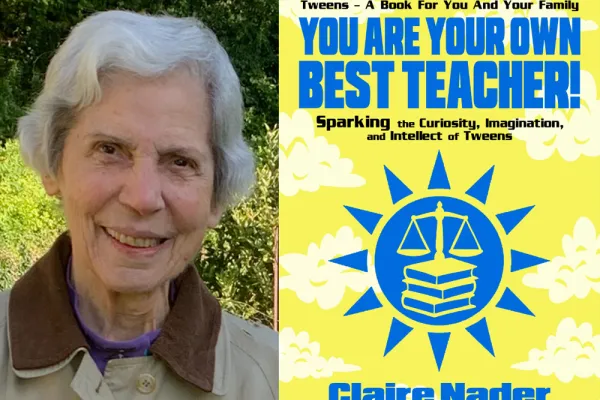Empowering Tweens
Alum News
Social scientist and author Claire Nader ’50 says the tween years are a perfect time to develop critical thinking skills that will serve them well throughout their lives

Published November 14, 2022
In her latest book, You Are Your Own Best Teacher! Sparking the Curiosity, Imagination and Intellect of Tweens, Claire Nader ’50 quotes Mark Twain as saying, “I’ve never let my schooling interfere with my education.”
The quote is central to the point Nader makes in her book that the creativity, curiosity, and idealism so central to childhood development and education are being lost at a time when teaching children how to be critical thinkers, make informed decisions, and realize they have the power to enact change is more important than ever. In addition to the traditional pressures children and young people experience growing up, Nader cites the onslaught of media misinformation and marketing as additional minefields.
Nader, a social scientist by profession, says tweens (generally children ages 9–12) are at an especially good age for processing the information in her book. They are bubbling with questions, ideas, and creativity. “In this age group, they don’t think they know everything,” says Nader, “and they are eager to learn. This book will help them to have clarity about what they want and don’t want.”
The digital world is an important area that tweens need to understand how to navigate, Nader says. “The [smartphone] internet gulag is everywhere,” she says. And advertisers are targeting children and tweens through myriad ways (games, social media, videos) to sell junk food, toys, e-cigarettes, and more. “No wonder parents feel that they are losing control over their children,” says Nader. “This is the first time in history that we are undermining parental authority.”
In addition to offering sensible advice, Nader provides helpful information. For example, she guides tweens on a tour of the print dictionary (something most tweens have never held in their hands) and discusses important concepts like justice, wisdom, and freedom. She also talks about historical figures such as Frederick Douglass and Helen Keller to show how awareness and discipline impacted their lives. Throughout the book, she cites numerous examples of tweens who have changed the world—think Malala Yousafzai.
Nader, who is the older sister of political activist and 2000 presidential candidate Ralph Nader, was a Latin American studies major at Smith who enjoyed walking on campus and spending time in the botanic garden. After earning a Ph.D. in public law and government from Columbia University, she studied technology’s impact on society and has advocated for numerous causes at the local, national, and international level. In the 1960s, she was director of science in society studies at the Oak Ridge National Laboratory, where she conducted research on societal aftereffects of nuclear attacks. In the 1990s, she chaired the Council for Responsible Genetics based in Cambridge, Massachusetts.
Nader says her parents never talked down to her as a child, and she took that approach when writing You Are Your Own Best Teacher! “If your expectations are low, they’ll oblige you,” says Nader. “If your expectations are high, and they know it, they will surprise you.”
That doesn’t mean that tweens should read the book in a vacuum. Ideally, Nader would also like adults to read You Are Your Own Best Teacher! and use the chapters as conversation starters. Nader says, “A lot of discussion needs to happen between tweens and their parents or the responsible adults in their life.”
She is less enthusiastic about the possibility of teacher/student discussions based on You Are Your Own Best Teacher! “You want children to feel free to express themselves—to ask the uncomfortable questions—the ‘why’ questions,” says Nader. “But the educational system needs order more than critical thinking.”
Reaction to the book so far has been very positive, with a wide range of endorsement blurbs ranging from notables like punk poet/singer/author Patti Smith to classmate Helene Hill ’50, professor emerita at Rutgers University’s Department of Radiology. Nader is excited about the possibility of developing discussion programs based on the book for local libraries. “You want these youngsters to start thinking outside the box,” says Nader. “And they’re ready. But they need to be anchored in reality, community, and nature—not the phone they’re using.”
Photograph of Claire Nader ’50 by Nadia Milleron ’86